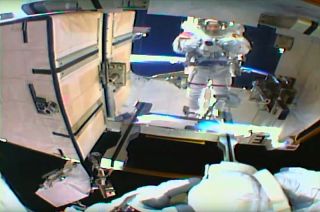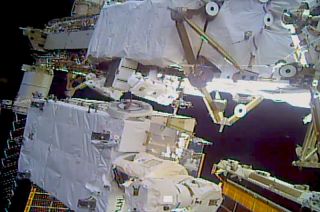Astronauts honor Martin Luther King, Jr. and replace ISS batteries on 3rd all-woman spacewalk – Space.com
HOUSTON — Two astronauts completed battery replacements and honored the legacy of the late Martin Luther King, Jr. while working outside of the International Space Station on what marked the third all-woman spacewalk today (Jan. 20).
NASA astronauts Jessica Meir and Christina Koch performed their third extravehicular activity (EVA, or spacewalk) as a pair, completing upgrades to one of the space station’s four power channels. The two made history on their first EVA together in October, as the first two women to work in the vacuum of space together.
“This has really been an amazing experience, being part of this Expedition 61 EVA team,” said Meir. “Today is also Martin Luther King Day, a personal hero for both me and Christina. I will borrow his wise words for this moment: ‘We may have all come on different ships, but we are in the same boat now.'”
Related: The amazing spacewalks of Expedition 61 in photos

“When one has as spectacular view as we had today looking down on our one common home, planet Earth, his words resonate loudly,” Meir said once back inside the airlock at the end of the spacewalk.
“We often say how much we owe to those who paved the way, and that doesn’t just mean in spaceflight. It also means those who worked for civil rights and inclusion,” added Koch. “That is why it is so meaningful for us today to be out here on this day we honor Martin Luther King, Jr., who paved the way, not only for us, but for so many that have a dream.”
During today’s 6-hour and 58-minute spacewalk, Meir and Koch removed two old nickel-hydrogen batteries that since 2010 have stored power for the far port, or left side, solar arrays mounted to the station’s backbone truss and replaced them with a more capable lithium-ion battery. The two also installed two adapter plates to enable the station’s integrated electronics assembly (IEA) to work with the new battery.
The work required Meir and Koch to move the large batteries between the IEA and an external pallet held in place by the station’s Canadarm2 robotic arm. Each battery measured about half the size of a refrigerator, or 40 inches long by 37 inches wide by 19 inches high (101 by 94 by 48 centimeters). The old nickel-hydrogen batteries weighed 365 lbs. (165 kilograms) each. The lithium-ion replacements weighed 428 lbs. (194 kg).
The spacewalk completed the battery replacements on the port 6 (P6) IEA, leaving it configured with three new lithium-ion batteries in place of its previous six nickel-hydrogen units. The new lithium-ion batteries are more powerful, such that just one can serve in the place of two of the decade-old nickel-hydrogen batteries.
Meir and Koch installed the two other lithium-ion replacements during a spacewalk on Jan. 15.
“With your diligent work, you have restored the 4B [power] channel to full strength. We thank you for your work and it has been a pleasure to work with you,” said astronaut Stephanie Wilson from inside Mission Control at NASA’s Johnson Space Center in Houston, from where she was helping to guide Meir and Koch through the spacewalk’s tasks.

With the P6 electronics assembly work now complete, three of the space station’s four power channels have been outfitted with new batteries. Astronauts working on spacewalks since 2017 have now replaced 36 of the orbiting laboratory’s 48 nickel-hydrogen batteries with the lithium-ion upgrades.
All that remains are the starboard, or right-side, inboard battery replacements for a future series of spacewalks to complete. Like the earlier installed units, the new batteries for that IEA will be delivered by a Japanese H-II Transfer Vehicle (HTV) cargo vehicle.
After completing their battery tasks, Koch and Meir worked to clean up their worksite and ran into issues stowing a portable foot restraint. The two also paused to re-stow a control panel for Koch’s SAFER, a contingency jetpack attached to her spacesuit, which unexpectedly came loose.
Monday’s EVA, which began at 6:35 a.m. EST (1135 GMT) ended at 1:33 p.m. EST (1933 GMT), marked Meir’s third and Koch’s sixth career spacewalks.
Meir, who served as EV1 (or lead spacewalker) and wore the Extravehicular Mobility Unit (EMU) spacesuit with red stripes, has now logged a total of 21 hours and 44 minutes on her three EVAs. Koch, who as EV2 wore the suit with no identifiers, has a total of 42 hours and 15 minutes spanning her six spacewalks.
This was the 226th EVA devoted to the International Space Station since assembly of the orbiting outpost began in 1998.
The next EVA is scheduled for Saturday (Jan. 25), when NASA astronaut Andrew Morgan and European Space Agency (ESA) astronaut Luca Parmitano will work to complete earlier repairs to the Alpha Magnetic Spectrometer, a cosmic-ray detector.
Robert Pearlman is a Space.com contributing writer and the editor of collectSPACE.com, a Space.com partner site and the leading space history news publication. Follow collectSPACE on Facebook and on Twitter at @collectSPACE. Follow us @Spacedotcom, Facebook.







